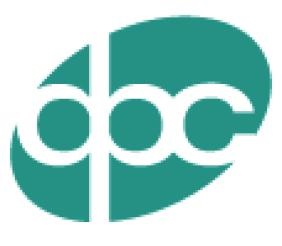
Illustration by Jørgen Stamp digitalbevaring.dk CC BY 2.5 Denmark
Development of the Handbook
The Handbook was first created in 2001 as a print publication Preservation Management of Digital Materials: a Handbook, printed by British Library Publishing (Jones and Beagrie, 2001). A limited edition CD of the Handbook was produced in February 2002 for the launch of the DPC at the House of Commons. The online digital version of the Handbook was made available on the DPC website shortly after this in May 2002. An archived version of this "first online edition" of the Handbook is available in the UK Web Archive (UKWA, 2009).
For over a decade subsequently, the online edition of the Handbook has provided an internationally authoritative and practical guide to the subject of managing digital resources over time and the issues in sustaining access to them. However, only a few small additions have been made to the Handbook since it was made available online. The DPC set itself a strategic target to raise research grant funding to completely update the Handbook and integrate it more closely with the Technology Watch series to maintain its future currency and ease of updating.
In 2014, The National Archives (TNA) as lead funder with supplementary funding from the Archives and Records Association, British Library, Jisc, and National Archives of Scotland, provided a research grant to begin the full revision of the Handbook and promoting its use and uptake. This work was undertaken under the direction of William Kilbride Director of the DPC and the editor Neil Beagrie, and has been supported by an extensive advisory board and set of contributors.
The Digital Preservation Coalition (DPC) is a not-for-profit organisation that makes the Digital Preservation Handbook freely available as an online resource: it is heavily used for Continuous Professional Development, by university students, and for training in digital preservation. A review of digital preservation training by the APARSEN project has highlighted the narrow range of topics covered by most initiatives (APARSEN, 2012). It highlights current gaps in topic coverage that suggested an updated revised edition of the Handbook would meet ongoing needs.
As part of preparation for the 2nd edition, a mapping was undertaken between the Handbook and Aparsen recommendations and also to the DigCurV Curriculum Framework for Digital Curation (DigCurV, 2013). Extensive audience research informed the Handbook's proposed development and this included input from 285 members of the community via an online survey (DPC, 2014a) and a public consultation on a draft content outline (DPC, 2014b).
The Harvard System has been used for references, in the same style as the DPC Technology Watch Reports.
This focus on engaging the digital preservation community to ensure the Handbook represents the needs of a broad range of organisations and sectors, has continued through its revision via use of collaborative "book-sprints" and its Advisory Board.
Acknowledgements
The Second Edition of the Digital Preservation Handbook was delivered from a collaborative research project based on a consortium agreement between The National Archives, The Archives and Records Association, the British Library, Charles Beagrie Ltd, the Digital Preservation Coalition, and Jisc.
- The project funding was initiated by The National Archives. Aware of the digital preservation challenge faced by the archives sector and responsive to its role to provide strategic sector leadership, it offered 50% of the estimated required project funds (ie Gold Sponsorship) on the understanding that the DPC should either find the remaining funds by attracting additional sponsors or underwrite the costs directly.
- The DPC Board, eager to revise the Handbook, agreed to the offer from The National Archives, offering DPC staff time and ensuring that material costs (such as the website) would be supplied at no cost. The DPC also made a cash contribution from member funds.
- Charles Beagrie Ltd joined the consortium as the editorial partners to undertake original research, develop content and design, and co-ordinate quality assurance. Charles Beagrie Ltd provided an in-kind contribution of staff time (equivalent to Bronze Sponsorship), helping to underwrite the final editorial tasks to complete the Handbook.
- Jisc joined the collaboration early recognising that archivists and research data managers in higher education would be well placed to use the Handbook. Jisc’s funds (Silver Sponsorship) enabled the development of the three content specific preservation sections and the ‘book sprint’ methodology.
- The British Library also joined the collaboration early, reflecting their role in the original Handbook. Funds from the British Library (Silver Sponsorship) enabled a comprehensive needs assessment and survey which formed the basis of the revised table of contents.
- After a period of content development and proto-typing, the Archives and Records Association (ARA) joined the collaboration offering funds (Silver Sponsorship) from their own research grants, ensuring that draft texts were systematically and comprehensively peer-reviewed prior to release, and that the DPC was able to take the Handbook ‘on the road’ in a series of training events accessible to ARA members.
- Finally funds were supplied from the National Records of Scotland (Bronze Sponsorship) to enable wide dissemination and timely launch.
The DPC Board formally thanks the partners, noting also the many additional contributions, introductions and encouragements that they made to the successful completion of the project.
Funders
Gold sponsor |
 |
Silver sponsors |
 |
 |
Bronze sponsors |
 |
 |
digitalbevaring.dk has kindly given permission for use of the illustrations in the section headings of the Handbook and the icons in the Resources and Case Studies, produced by Jørgen Stamp. These are copyright of digitalbevaring.dk and shared under a CC BY 2.5 Denmark licence (illustrations) https://creativecommons.org/licenses/by/2.5/dk/deed.en_GB , and a CC0 1.0 licence (icons) https://creativecommons.org/share-your-work/public-domain/cc0.
Handbook Managing Editor: Sharon McMeekin (from June 2016)
Previous Managing Editor: Neil Beagrie (until June 2016)
Handbook Contributors
| Matthew Addis |
Arkivum Ltd (book sprint 1) |
| Neil Beagrie |
Charles Beagrie Ltd (book sprint 1, book sprint 2, book sprint 3, book sprint 4, Cloud services, Glossary, Handbook 1st edition, Introduction, e-journals preservation case study, Resources and case studies) |
| Daphne Charles |
Charles Beagrie Ltd (Handbook web content design and input, desk research and audience research for Handbook) |
| Andrew Charlesworth |
University of Bristol (Cloud services) |
| Tracey Clarke |
University of Sheffield (book sprint 3) |
| Glenn Cumiskey |
British Museum (book sprint 2) |
| Stefanie Davidson |
West Yorkshire Archive Service (book sprint 1) |
| Michael Day |
British Library (book sprint 1) |
| Matt Faber |
Jisc (book sprint 1, book sprint 2) |
| Chris Fryer |
Parliamentary Archives (book sprint 1) |
| Dave Govier |
Manchester Met Archives Network (book sprint 3) |
| Stephen Grace |
University of East London (book sprint 2) |
| Alex Green |
The National Archives (book sprint 2) |
| Edith Halvarsson |
British Library (book sprint 3) |
| Anna Henry |
Tate Gallery (book sprint 1) |
| Sarah Higgins |
University of Aberystwyth (book sprint 3) |
| Jeremy Leighton John |
British Library (Digital forensics) |
| Maggie Jones |
formerly Digital Preservation Coalition (Handbook 1st edition) |
| William Kilbride |
Digital Preservation Coalition (book sprint 1, book sprint 3, book sprint 4) |
| Gareth Knight |
London School of Hygiene and Tropical Medicine (book sprint 2) |
| Sharon McMeekin |
Digital Preservation Coalition (book sprint 2, book sprint 3, book sprint 4) |
| Paul Miller |
Cloud of Data (Cloud services) |
| Jenny Mitcham |
University of York (book sprint 3) |
| Laura Peaurt |
University of Sheffield (book sprint 3) |
| Maureen Pennock |
British Library (Web archiving) |
| Ed Pinsent |
University of London Computer Centre (book sprint 1) |
| Virginia Power |
Jisc (book sprint 1) |
| Vicky Stretch |
Network Rail (book sprint 3) |
| Susan Thomas |
Bodleian Library University of Oxford (book sprint 1) |
| Dave Thompson |
Wellcome Trust (book sprint 3) |
| Paul Wheatley |
Digital Preservation Coalition (book sprint 2, book sprint 3, book sprint 4) |
| Simon Wilson |
Hull University Archives (book sprint 3) |
| Richard Wright |
formerly BBC (Moving picture and sound) |
Management board
|
CHAIR: William Kilbride |
Digital Preservation Coalition |
|
John Chambers, Chris Fryer |
Archives and Records Association |
|
Maureen Pennock |
British Library |
|
Neil Beagrie (editor) |
Charles Beagrie Ltd |
|
Neil Grindley, Virginia Power, Matt Faber |
Jisc |
|
Emma Markiewicz, Matt Greenhall, Jane Anderson, Isobel Hunter |
The National Archives |
Advisory board
|
CHAIR: William Kilbride |
Digital Preservation Coalition |
|
Nancy Y McGovern |
MIT Libraries |
|
Marcel Ras |
NCDD, Dutch National Coalition for Digital Preservation |
|
Timothy Gollins |
The National Archives and National Records of Scotland |
|
Stefanie Davidson |
West Yorkshire Archive Service |
|
Sarah Higgins |
Department of Information Studies, Aberystwyth University |
|
Joy Davidson |
Digital Curation Centre, University of Glasgow |
|
Virginia Power & Matt Faber |
Jisc |
|
Anna Henry |
Tate Gallery |
|
Chris Fryer |
Parliamentary Archives |
|
Simon Tanner |
King's College London |
|
Michael Day |
British Library |
|
Susan Thomas |
Bodleian Library University of Oxford |
|
Carla Shields |
Public Record Office of Northern Ireland |
|
Marion Downie |
The National Archives |
|
Hania Smerecka |
Lloyds Banking Group Archives |
Peer reviewers
We would also like to record our thanks to the 26 individuals who have contributed to peer review of draft sections of the Handbook relevant to their areas of expertise and interest. We are grateful to members of the advisory board and in addition to Hugh Campbell (Public Record of Northern Ireland), Andrew Charlesworth (University of Bristol), Carey Clifford (Grosvenor Group), Lee Hibberd (National Library of Scotland), Neil Jefferies (University of Oxford), Catherine Jones (Science and Technology Facilities Council), Naomi Korn (Naomi Korn Copyright Consultancy Ltd ), Ingrid McDonald (Queensland State Archives), Laura Molloy (University of Oxford), Barbara Sierman (KB), Charlene Taylor (Worcestershire Archive & Archaeology Service), Kate Watson (Dorset County Council), Rebecca Webster (UCL Institute of Education), and Cathy Williams (The National Archives) for their reviews and suggestions that have made very significant contributions to the Handbook.
References
APARSEN, 2012. D43.1 Survey for the Asssessment of Training Material/Assessment of Digital Curation Requirements. Available: https://www.dpconline.org/docs/knowledge-base/1817-2012-02-21-aparsen-d43-1/file
DigCurV, 2013. A Curriculum Framework for Digital Curation. Available: https://www.digcurv.gla.ac.uk/
DPC, 2014a. Report on the Preparatory User Consultation on the 2nd Edition of the Digital Preservation Handbook. Available: https://www.dpconline.org/docs/miscellaneous/advice/1251-handbook-survey-response-summary-redacted/file
DPC, 2014b. Draft Outline of the 2nd Edition of the Digital Preservation Handbook. Available: https://www.dpconline.org/docs/miscellaneous/advice/1306-handbook-new-contents/file
Jones, M. & Beagrie, N., 2001. Preservation Management of Digital Materials, A Handbook. The British Library
UKWA (UK Web Archive), 2009. 8 captures (April 2008-December 2009) of the first edition of the online version of the Handbook. Available: https://www.webarchive.org.uk/wayback/archive/20090317142605/http://www.dpconline.org/graphics/handbook/
